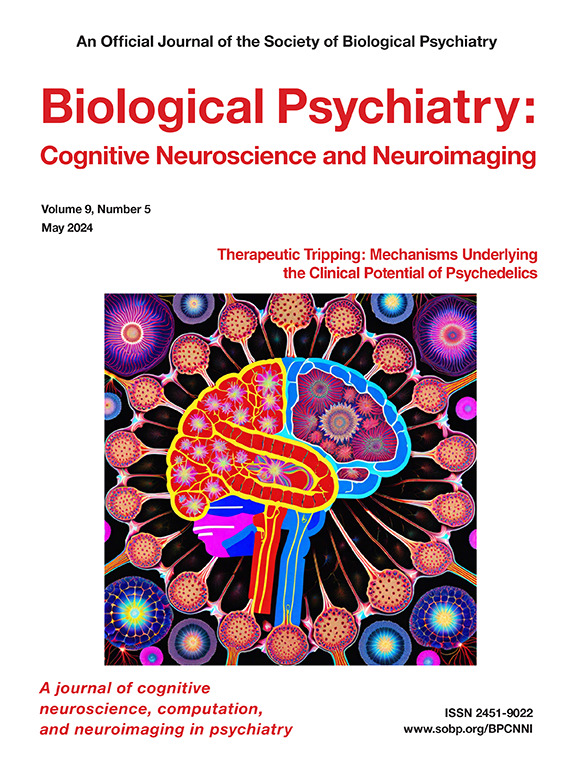多面性学习揭示了青少年大脑与环境之间的非线性相互作用,这种相互作用可预测青少年的情绪和行为问题。
IF 4.8
2区 医学
Q1 NEUROSCIENCES
Biological Psychiatry-Cognitive Neuroscience and Neuroimaging
Pub Date : 2025-05-01
DOI:10.1016/j.bpsc.2024.07.001
引用次数: 0
摘要
背景:要使青少年心理健康研究超越目前的成就--在不了解环境中神经生物学嵌入的情况下对大脑和环境风险因素进行复杂的描述--我们需要一些方法来揭示发育中的大脑与真实世界环境经历之间的关系:方法:我们利用青少年大脑和认知发展研究(Adolescent Brain and Cognitive Development Study)的参与者(N=2,401 名女性)调查了大脑功能、环境、情绪和行为问题之间的关联。我们应用了流形学习,这是一种从功能磁共振成像(fMRI)等高维生物医学数据中发现潜在结构的有效技术。具体来说,我们开发了外源 PHATE(E-PHATE)来模拟大脑与环境的相互作用。我们使用 E-PHATE 嵌入参与者在情绪和认知处理过程中的大脑激活情况,来预测认知、情绪和行为问题的个体差异:基线时参与者大脑激活和环境的 E-PHATE 嵌入显示,在多个皮层下区域和大规模皮层网络中,与基线时的总问题、外化问题和内化问题存在中度到高度的关联,而体素或 PHATE 方法的影响则为零到很小。基线时大脑和环境的 E-PHATE 嵌入也与两年后的情绪和行为问题有关。这些纵向预测显示,在前顶叶和注意力网络中存在一致的、适度的影响:结论:青少年大脑在环境中的嵌入可丰富对情绪和行为问题的洞察力。通过使用 E-PHATE,我们展示了如何将前沿计算方法与长期发展理论相协调,从而推进对青少年情绪和行为问题的检测和预测。本文章由计算机程序翻译,如有差异,请以英文原文为准。
Manifold Learning Uncovers Nonlinear Interactions Between the Adolescent Brain and Environment That Predict Emotional and Behavioral Problems
Background
To progress adolescent mental health research beyond our present achievements—a complex account of brain and environmental risk factors without understanding neurobiological embedding in the environment—we need methods to uncover relationships between the developing brain and real-world environmental experiences.
Methods
We investigated associations between brain function, environments, and emotional and behavioral problems using participants from the Adolescent Brain Cognitive Development (ABCD) Study (n = 2401 female). We applied manifold learning, a promising technique for uncovering latent structure from high-dimensional biomedical data such as functional magnetic resonance imaging. Specifically, we developed exogenous PHATE (potential of heat-diffusion for affinity-based trajectory embedding) (E-PHATE) to model brain-environment interactions. We used E-PHATE embeddings of participants’ brain activation during emotional and cognitive processing tasks to predict individual differences in cognition and emotional and behavioral problems both cross-sectionally and longitudinally.
Results
E-PHATE embeddings of participants’ brain activation and environments at baseline showed moderate-to-large associations with total, externalizing, and internalizing problems at baseline, across several subcortical regions and large-scale cortical networks, compared with the zero-to-small effects achieved by voxelwise data or common low-dimensional embedding methods. E-PHATE embeddings of the brain and environment at baseline were also related to emotional and behavioral problems 2 years later. These longitudinal predictions showed a consistent moderate effect in the frontoparietal and attention networks.
Conclusions
The embedding of the adolescent brain in the environment yields enriched insight into emotional and behavioral problems. Using E-PHATE, we demonstrated how the harmonization of cutting-edge computational methods with longstanding developmental theories advances the detection and prediction of adolescent emotional and behavioral problems.
求助全文
通过发布文献求助,成功后即可免费获取论文全文。
去求助
来源期刊

Biological Psychiatry-Cognitive Neuroscience and Neuroimaging
Neuroscience-Biological Psychiatry
CiteScore
10.40
自引率
1.70%
发文量
247
审稿时长
30 days
期刊介绍:
Biological Psychiatry: Cognitive Neuroscience and Neuroimaging is an official journal of the Society for Biological Psychiatry, whose purpose is to promote excellence in scientific research and education in fields that investigate the nature, causes, mechanisms, and treatments of disorders of thought, emotion, or behavior. In accord with this mission, this peer-reviewed, rapid-publication, international journal focuses on studies using the tools and constructs of cognitive neuroscience, including the full range of non-invasive neuroimaging and human extra- and intracranial physiological recording methodologies. It publishes both basic and clinical studies, including those that incorporate genetic data, pharmacological challenges, and computational modeling approaches. The journal publishes novel results of original research which represent an important new lead or significant impact on the field. Reviews and commentaries that focus on topics of current research and interest are also encouraged.
 求助内容:
求助内容: 应助结果提醒方式:
应助结果提醒方式:


